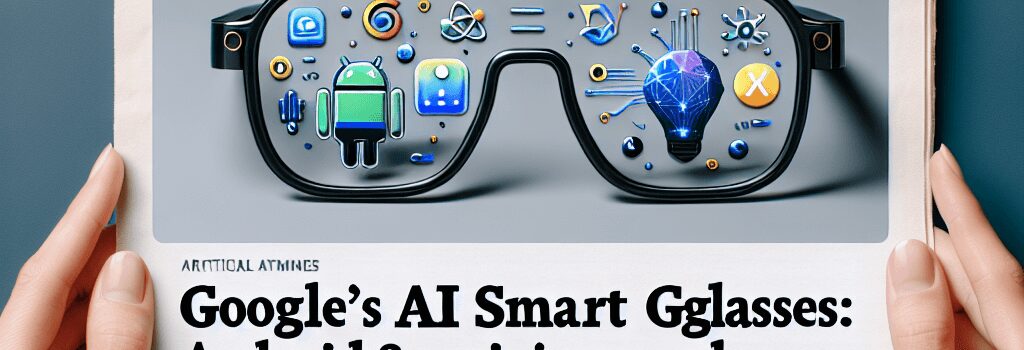Google’s AI Smart Glasses: Android XR and Gemini-Powered

Thirteen years after the original Google Glass and amid rising competition from Meta and Apple, Google is back with Android XR – a next-generation augmented reality platform built around its Gemini AI. At Google I/O 2025, attendees tried two reference designs: Samsung’s Project Moohan headset and a pair of prototype smart glasses that promise hands-free access to Google’s generative AI. Here’s a deep dive into the hardware, software and the lessons Google has learned from its Glass debut.
Android XR: Designed for the Gemini Era
Android XR is Google’s first OS native to the “Gemini era,” integrating on-device inference with cloud-backed AI services. Key technical specifications include:
- CPU/GPU: Custom Tensor-X3 chip with 8-core Cortex-A78 CPU and Mali-G78 GPU for low-latency vision processing
- Display: 720×540 micro-OLED panel per eye, 45° diagonal field of view, 90 Hz refresh rate
- Connectivity: Wi-Fi 6E (802.11ax), Bluetooth 5.3 LE, optional 5G via companion phone
- Sensors: Dual-camera stereo depth, IMU fusion (accelerometer, gyroscope, magnetometer)
- Battery: 600 mAh in glasses (4 hr active), 2,000 mAh in Moohan (6 hr mixed use)
These hardware capabilities feed real-time object recognition, spatial mapping and seamless hand tracking. For example, the Moohan headset uses passthrough video at 60 fps to overlay context-aware UI elements on the real world – similar to Apple Vision Pro, but driven by Google’s AI stack and app ecosystem.
Prototype Smart Glasses: Wearable AI for Everyday Use
Unlike bulkier AR/VR headsets, Google’s prototype glasses weigh just 45 g and feature:
- Single-lens display: Injects semi-transparent text and icons directly into your central vision
- Audio: Open-ear bone-conduction speakers for ambient awareness
- Interaction: Touch-sensitive temple surfaces for Gemini activation, voice commands and gesture control
- Companion app: Gemini Live streams low-res video to Google Cloud Vision APIs for advanced scene understanding
In a demo area filled with artwork, postcards and an espresso machine, users could tap to ask Gemini: “Who painted this?” or “What’s the recipe for this roast?” Answers appear as floating text and can be translated in real time – a feat of sub-200 ms round-trip latency when connected to a strong Wi-Fi 6E network.
Lessons Learned: From Glass to Android XR
“I made a lot of mistakes with Glass – from supply chain to pricing,”
— Sergey Brin, Google co-founder
Brin acknowledged that the original Glass’s $1,500 price tag and niche app support limited adoption. This time, Google partners with:
- Samsung: Builds on its manufacturing scale and uses PMOLED suppliers qualified for automotive HUDs
- Gentle Monster & Warby Parker: Focus on industrial design, aiming for sub-$400 retail prices and four stylish frames
Hardware and Supply Chain Improvements
Analyst firm IDC projects AR headset shipments to grow at a CAGR of 23% through 2028. Google’s strategy includes:
- Multi-sourcing critical components (micro-OLED from Sony & BOE)
- Regional assembly lines in Vietnam and Mexico to reduce tariffs and lead times
- Modular battery packs swappable in seconds for enterprise use cases
“By leveraging proven smartphone vendors for displays and chip packaging, Google can avoid the bottlenecks that dogged Glass,” notes industry analyst Maria Chen of TechInsights.
Privacy, Security and Data Management
Continuous video streaming poses privacy risks. Android XR implements:
- On-device anonymization: Face-blurring of bystanders before cloud upload
- End-to-end encryption: DTLS 1.3 tunnels between glasses and Gemini Live servers
- Local AI sandbox: On-chip models for wake-word detection and common queries to minimize cloud calls
Google’s security lead, Dr. Ayesha Patel, explains: “We perform differential privacy aggregation for usage metrics, ensuring individual actions are never directly logged in the cloud.”
Industry Implications and Future Outlook
With Apple’s Vision Pro v2 update and Meta’s upcoming Snapdragon XR2 Gen3 platform, competition in AR is intensifying. Google’s strengths lie in its:
- Extensive AI research (Gemini’s 175 billion-parameter core)
- Cloud infrastructure (Edge TPU instances in 30 regions for low latency)
- Developer ecosystem (10,000+ ARCore apps ready for XR extension)
Rumors suggest a consumer launch in Q4 2025 with a starting MSRP of $349. Early adopters include logistics companies, field technicians and medical professionals. A locked-down enterprise SKU could ship as early as Q3.
Conclusion
Google’s second act in smart glasses aims to balance style, performance and AI prowess. By learning from past missteps, leveraging partnerships and embedding Gemini deeply into hardware, Android XR has a clear roadmap – if it can meet price and privacy expectations. The race for mainstream AR wearables is on, and this time, Google is playing for keeps.